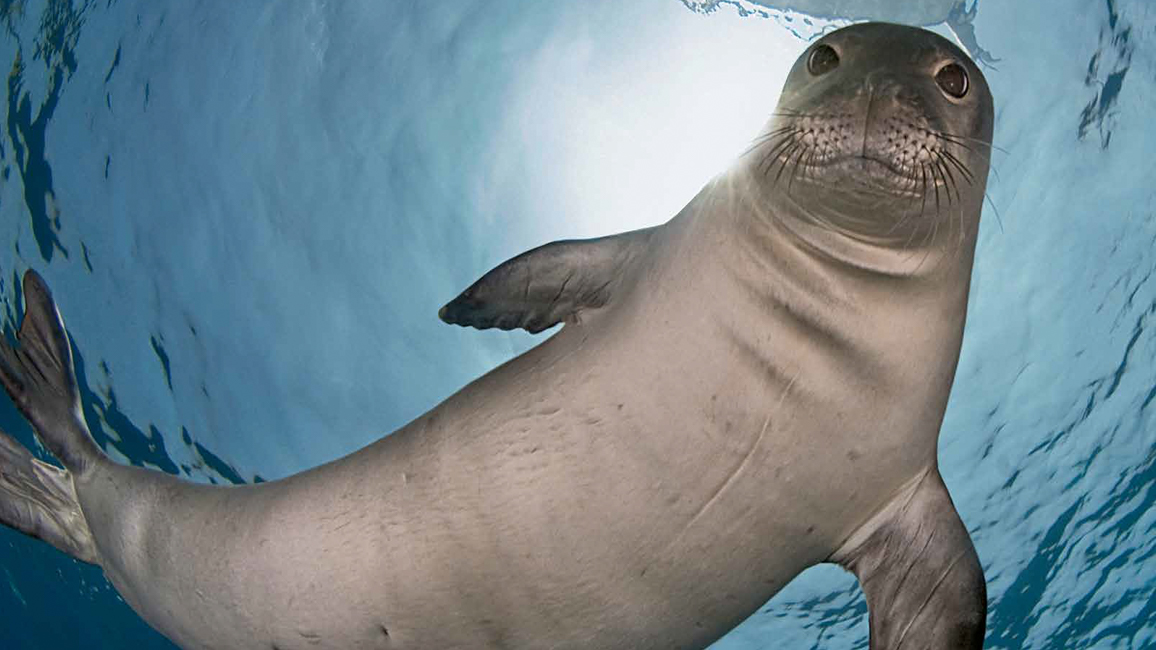
Hawaiian Monk Seals
By Clare Hodgson MeekerAs you might guess from their name, Hawaiian monk seals live in Hawaii and no place else in the world. Almost all of these seals are hidden away in the state’s quiet Northwestern Islands, though a small number also live around the busier main islands.
The Northwestern Islands are a faraway, peaceful home for the seals, with sandy beaches where they can rest and have their pups. Life should be good.
But sadly, monk seals have their share of problems. Competition with other animals for food can be fierce, and the seals—especially young ones—can’t always find enough. Many seals die from being tangled in fishing nets or other trash. Also, sharks and even adult male seals may attack seal pups.
Because of these and other problems, Hawaiian monk seals have become very endangered. But the good news is that people are working hard to try to help them.
FLIPPER POWER
Like all seals, a monk seal is built to swim fast and dive deep. Its powerful back flippers move it through the water, while its short front flippers steer. But when a seal hauls out on the beach, it moves less gracefully, “inchworming” its body along.
HUNGRY HUNTERS
Monk seals are not picky eaters, but they are known to play with their food before eating it. They hunt for eels, squid, octopus, small fish, and lobsters that hide in the cracks of coral reefs. Their big eyes help them see in the dim ocean light. And their stiff whiskers help them feel for a meal. Monk seals will also dive really deep to find food. They can hold their breath for up to six minutes when diving. When they’re sleeping underwater, they can hold it up to 20 minutes!
A MOTHER AND PUP
Pupping season for monk seals usually begins in early spring. A mother seal comes up onto the beach to give birth. For six weeks, she stays with her pup, never leaving—even to feed herself. Meanwhile, the pup gains over 100 pounds from drinking its mom’s rich milk. But when Mom finally leaves the pup, she is gone for good, and the young pup must fend for itself.
HELPING HANDS
Many things are being done to help save monk seals. The U.S. government gives protection to the seals under the Endangered Species Act. It has set aside the Northwestern Hawaiian Islands as a special protected area. And Hawaii made the monk seal its official state mammal to help draw attention to the seal’s struggle for survival.
Scientists are studying monk seals to learn more about them and how to help them. They put numbered tags on the flippers of pups so they can identify them. They keep track of how many monk seals survive each year. They also treat seals that have diseases or have been injured by swallowing fish hooks or getting tangled in old fishing nets.
These life-saving efforts, along with many years of collecting information are helping Hawaii’s 1,100 remaining monk seals to survive. About a third of the seals are alive today because people have helped to save them. Another hopeful sign is that, in the last 10 years, the number of monk seals on the main Hawaiian Islands has almost doubled.
CITIZEN SCIENTISTS
It’s not just scientists who are helping the seals. A group of volunteers called the Hawaiian Monk Seal Response Network also helps keep the seals safe. When the seals lie on the beach to rest, the volunteers create a “safety zone” around them to keep other people from getting too close. They also know a lot about monk seals and are helping to teach people about these special mammals. The hope is that, with a little help from their human friends, monk seals will be around for generations to come.
“Hawaii’s Special Seals” originally appeared in the October 2013 issue of Ranger Rick magazine.
(Click on each image above for a closer view of the story.)


















